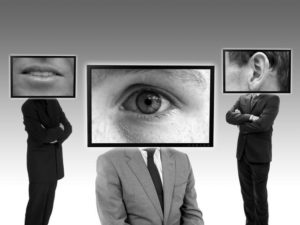Patent applications are just that, applications. They do not indicate that a product has been commercialized, or even the existence of an operational prototype. Patent applications do, however, give some indication of the research the patent applicant has been conducting behind close doors.
One patent application I found of particular interest is United States Patent Application Number US20160260135A1. This patent application, the Orwellian-entitled “Privacy-aware personalized content for the smart home,” envisions a home system that harnesses the Internet of Things, such as “computers, smart televisions, tablets, smart  thermostats, lighting systems, alarm systems, entertainment systems, and a variety of other electronic devices” to collect otherwise unattainable private homeowner data to provide the homeowner with more targeted content, such as advertising, that is more likely to result in “converting user viewing of the content to user interaction with the content.”
thermostats, lighting systems, alarm systems, entertainment systems, and a variety of other electronic devices” to collect otherwise unattainable private homeowner data to provide the homeowner with more targeted content, such as advertising, that is more likely to result in “converting user viewing of the content to user interaction with the content.”
If that does not sound frightening, I do not know what does. While the Google application does not come right out and provide a wiring diagram for Mr. Charrington’s junk shop honeypot, it is fairly easy to put two and two together in this application to come up with five. Google’s patent application describes deploying various types of sensors, such as microphones, cameras, passive infrared sensors, heart rate monitors, voice and facial recognition systems, etc. to determine things like the number and identity of all of the people in a room, the heat being given off by those people, their physical activity level etc. The application teaches combining that information with additional information received from other sensors, like microphones, to determine what is happening in a room and ostensibly using that data for the benefit of the homeowner in ways such as adjusting the thermostat, ambient lighting, music etc.
One of the less creepy suggestions in the application for use of the technology is to combine data from the sensors with rules-based inference engines or artificial intelligence provided through a cloud-computing system, to detect or monitor the progress of Alzheimer’s Disease in a homeowner.
A somewhat creepier use of the Google system involves combining data from the sensors with other data to make suggestions to the homeowner. One example given in the patent application is the system using a camera to identify a copy of the novel “The Godfather” on the homeowner’s nightstand, using optical character recognition to identify the title, and sending the homeowner the following message:
“I noticed you have a copy of ‘The Godfather’ by your bed. The movie based on this novel is showing tonight at 9:30 PM on channel 5.”
It is difficult to imagine that statement not being read in Hal 9000’s voice.
Another example provided in the patent application is the system using a camera to identify a “tee-shirt on a floor of the user’s closet and recognize the face on the tee-shirt to be that of Will Smith. In addition, the client device may determine from browser search history that the user has searched for Will Smith recently. Accordingly, the client device may use the object data and the search history in combination to provide a movie recommendation that displays, ‘You seem to like Will Smith. His new movie is playing in a theater near you.’”
Getting creepier for sure, but the scariest implementation can only be read between the lines of the application.
Google’s patent application notes in its description the use of video cameras, and placement of devices in ceilings and bedrooms. The system also details the use of application program interfaces to allow “applications executed by the third parties to initiate specific data processing tasks that are executed by the central server or the cloud-computing system 64, as well as to receive dynamic updates to the home data 82 and the derived home data 88.” Given all of the foregoing, it is not difficult to extrapolate that the system could be used to identify all of the people in a bedroom, infer the activity they are currently involved in, and send video of the activity to a third-party provider.
In fairness, the application does state that the system may be configured to use a private network to communicate the people/object data between devices to preserve the privacy of the user, since the data is not sent to the external server. So, if you trust the system to differentiate between the information you want maintained on your private network and the information to send to third party advertisers, this system may be for you. Otherwise, you may want to pass on installing this first generation privacy-aware personalized content in your bedroom.





Recent Comments